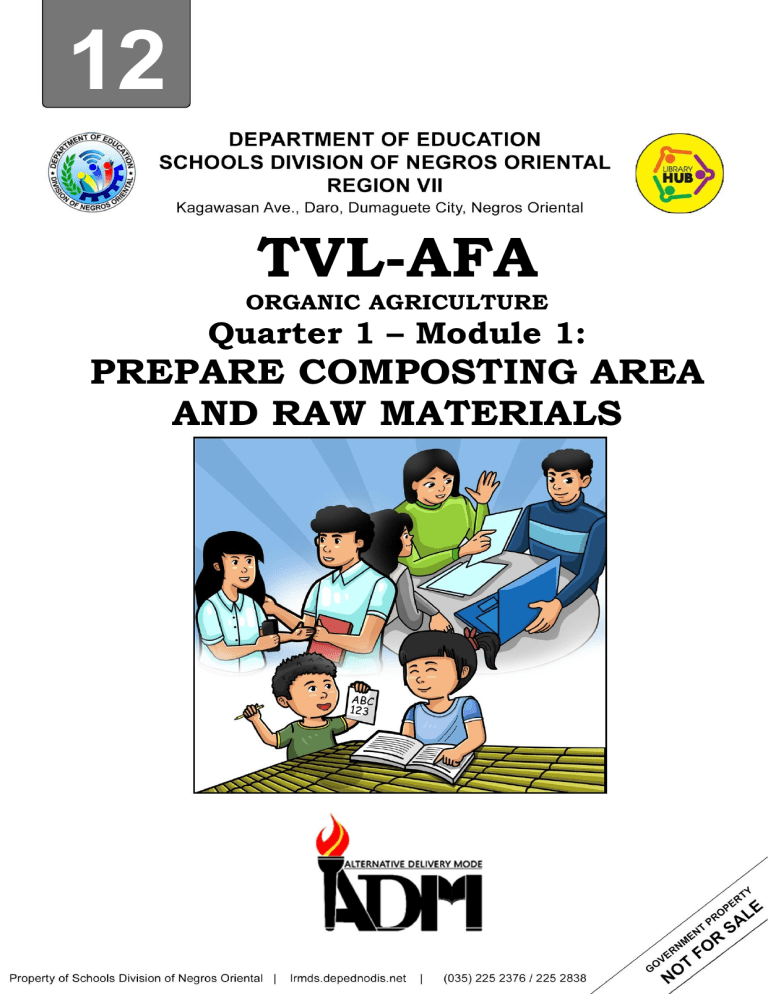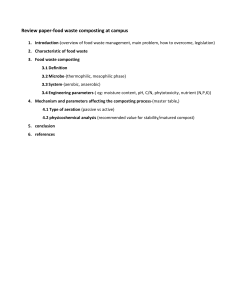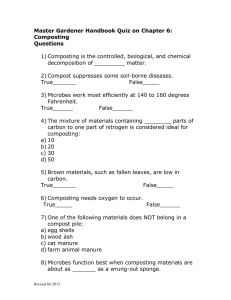Study on How to Prepare Composting Area and Raw Materials
advertisement

12 10 TVL-AFA ORGANIC AGRICULTURE Quarter 1 – Module 1: PREPARE COMPOSTING AREA AND RAW MATERIALS TLE – Grade 12 Alternative Delivery Mode Quarter 1 – Module 1 Prepare Composting Area and Raw Materials First Edition, 2020 Republic Act 8293, section 176 states that: No copyright shall subsist in any work of the Government of the Philippines. However, prior approval of the government agency or office wherein the work is created shall be necessary for exploitation of such work for profit. Such agency or office may, among other things, impose as a condition the payment of royalties. Borrowed materials (i.e., songs, stories, poems, pictures, photos, brand names, trademarks, etc.) included in this module are owned by their respective copyright holders. Every effort has been exerted to locate and seek permission to use these materials from their respective copyright owners. The publisher and authors do not represent nor claim ownership over them. Published by the Department of Education Secretary: Leonor Magtolis Briones Undersecretary: Diosdado M. San Antonio Development Team of the Module Writers: Rosie C. Baldelovar, Analiza Pampora Editors: Rosemarie Elum, Jonathan Bayaton, Jefferd Alegado Reviewers: Rosemarie O. Elum, Jonathan Bayaton Typesetter: Aisa C. Ibero, Rosie C. Baldelovar Layout Artist: Aisa C. Ibero Management Team: Senen Priscillo P. Paulin, CESO V Rosela R. Abiera Fay C. Luarez, TM, Ed.D., Ph.D. Maricel S. Rasid Adolf P. Aguilar Elmar L. Cabrera Nilita R. Ragay, Ed.D. Antonio B. Baguio, Ed.D. Printed in the Philippines by ________________________ Department of Education –Region VII Schools Division of Negros Oriental Office Address: Tele #: E-mail Address: Kagawasan, Ave., Daro, Dumaguete City, Negros Oriental (035) 225 2376 / 541 1117 negros.oriental@deped.gov.ph 12 TVL Quarter 1 – Module 1: Prepare Composting Area and Raw Materials (Select site based on compost fertilizer production requirement ) What I Need to Know This module was designed and written with you in mind. It is here to help you master the nature of Organic Agriculture. The scope of this module permits it to be used in many different learning situations. The language used recognizes the diverse vocabulary level of students. The lessons are arranged to follow the standard sequence of the course. But the order in which you read them can be changed to correspond with the textbook you are now using. After going through this module, you are expected to: 1. select site based on compost fertilizer production requirement; 2. gather some organic materials that are available at home or in the community; and 3. identify organic materials readily available in the community that can be used in making compost fertilizer. ii What I Know A. MULTIPLE CHOICES Direction: Read each item carefully. Write the correct answers in your notebook. Let us determine how much you already know about composting. 1. It is the process of transforming organic materials of plant or animal origin into humus in heaps or pits? a. composting b. vermin-composting c. heating phase d. Decomposition 2. Which of the following is an example of brown manure? a. Sawdust b. Kitchen wastes c. Grass cuttings d. Greens 3. Why do we need to select an appropriate site based on compost fertilizer production requirements? a. The location of a composting operation directly impacts the amount of site preparation required and the measures needed to satisfy environmental and regulatory requirements. b. Proper site selection is a prerequisite to the establishment of safe and effective composting operations. c. Are necessary to minimize potential environmental conflicts between noncompatible land uses, to minimize odor related problems, and to ensure the integrity of groundwater systems. d. All of the above 4. The separation distances for composting facilities of a private well must be? a. 300 m b. 400 m c. 500 m d. 150 m 5. Why use compost? a. There is a need for sustainable production through integrated nutrient management b. It solves problems on declining yield. c. It solves problems on declining yield. d. All of the above 1 Lesson 1 PREPARE COMPOSTING AREA AND RAW MATERIALS In this module, you will be learning the basic concepts of composting and the raw materials that can be used in composting. Prepare for a fun-filled learning ahead. What’s In 1. What is the importance of knowing the different materials of composting? 2. Why do you think that there are materials that we should need to avoid in Making compost? 3. Give one advantage of using organic fertilizer? What’s New Composting is nature's way of recycling. According to the website of Resource Recovery and Waste Management Division, yard waste and food waste are broken down and become food for plants. Organic wastes, such as food waste and yard waste, make up 25 to 50% of what people throw away. While you may not be able to compost all of the organic waste you generate, composting can significantly cut down on your overall trash. Applying compost to your soil makes for happy plants and a better time tending your garden. 2 What is It Select site based on compost fertilizer production requirement Compost and composting Compost is a mixture of decayed organic materials decomposed by microorganisms in a warm, moist, and aerobic environment, (oxygen-breathing) releasing nutrients into readily available forms for plant use. Why use compost? ⚫ There is a need for sustainable production through integrated nutrient management. ⚫ Compost produces less methane than non-decomposed rice straw when incorporated in the soil. ⚫ It solves problems on declining yield. ⚫ It also corrects micronutrient problems like zinc deficiency. Composting is the controlled decay of plant and animal wastes to produce compost, a dark, rich soil-like material. Compost is added to the soil to improve its structure and nutrient content. In nature, bacteria, fungi, worms, and other soil organisms help in breaking down dead plants and animals, as well as animal wastes. Decomposed organic material becomes part of the soil. This natural decay usually takes place very slowly. To speed up the process, composters create ideal growing conditions for compost organisms. Site Selection for Compost Piles Proper site selection is a prerequisite to the establishment of safe and effective composting operations. The location of a composting operation directly impacts the amount of site preparation required and the measures needed to satisfy environmental and regulatory requirements. Site Selection Guidelines Separation distances are necessary to minimize potential environmental conflicts between non-compatible land uses, to minimize odor related problems, and to ensure the integrity of groundwater systems Table 1. Separation Distances for Composting Facilities Separation Distance Neighbouring Properties: 3 dwelling 400m commercial building 300m industrial building 300m Farm 100m Roadways: Right of way of a local road and arterial or collector highways 50m Watercourses: rivers/streams 150m private well 150m lakes 300m Buffer Zones: minimal buffer strip between a composting facility boundary and adjacent property 30m Table 1 indicates the recommended separation distances. However, these may be modified, if deemed necessary by the environmental inspector, to make a project environmentally acceptable. Modifications will be based on the type of material to be composted, the composting site, operational procedures, etc. The composting facility shall not be located in areas subject to flooding and where the seasonal high groundwater table is less than 1 meter from the groundwater table or where the minimal depth to bedrock is less than 1.5 meters. The composting facility shall not be located within a protected watershed as defined by the Clean Water Act. The composting facility shall be located on a surface with a slope of between 1% and 6%. The Department must obtain a letter from the development officer of a municipality or a District Planning Commission stating the proposed project conforms to local planning regulations relative to land use provisions adopted for the area under the Community Planning Act. The proponent shall notify the owner(s) whose property is located within 1/2 kilometer from the proposed composting facility before issuing an Approval. Composting Site Selection Incorrect compost site selection can cause major problems, both in the short and long term. Can start with a preliminary sketch. ⚫ Prevailing winds ⚫ Traffic flow ⚫ Landscape ⚫ Run-off 4 ⚫ ⚫ Buffer ⚫ ⚫ ⚫ Surrounding land uses Environment information Zone To minimize potential environment impacts To protect water sources Horizontal and vertical separation Consideration when selecting a site ⚫ Dwelling ⚫ Commercial buildings ⚫ Industrial buildings ⚫ Farm ⚫ Roadway ⚫ Water sources ⚫ Water table ⚫ Bedrock General Area Requirements Depends on compost technology (windrows or in-vessel) Throughput Raw materials storage Space for the finished product Buffer areas (odor, noise, pollution control) Holding ponds Fire lane Truck queuing Vehicle parking Future expansion Biofilter (could be 50% of total surface area for composting) Area Requirements for windows Equipment Volume of material handled Shape of the pile Daily volume of material to be composted Pile dimension Windrows volumes and numbers Sketch layout Area Requirements for In-Vessel (not generally for green waste) Far less than windrows a. The volume of finished compost b. Curing time c. Pile height and spacing d. equipment movements Curing and Storage About ½ of the original volume Area requirements can vary from 25% to 200% of the size of composting area Spacing requirements depend on a. volume of finished compost 5 b. length of time required for curing and storage c. Pile height and spacing d. Equipment movement Other considerations Composting surface 1%-6% slope Avoid flood plains, high ground preferable Drain to the setting pond then normal runoff Downwind of the sensitive receptor (odor, dust, etc.) Aesthetics Animal byproducts (not usually applicable for green waste) Water quality a. Managed through proper siting, compost mixtures, pile management Runoff and Leachate a. Can be managed through good composting b. Land application and recirculation of runoff Odor Vectors Dust Noise Fire hazards What’s More Study the figure below. Answer the following questions as your guide. Write your answers in a separate sheet. 1. What does the picture shows? 2. Why does site lay outing important? 3. What are the possible effect of putting compost site in an improperly? 6 What I Have Learned Direction: Give your insight or understanding of the following terms. Write your answers in your notebook. 1. 2. 3. 4. 5. Compost Site selection Compost piles Siltation Erosion What I Can Do Instruction: Go out and gather different organic materials found outside your home. Do not forget to wear your protective equipment while doing the activity. Be careful in using sharp objects. Please observe Occupational Health and Safety always. Take photos of every activity that you perform. Criteria for gathering organic materials Criteria Quality Quantity 30 points Assembled organic fresh, juicy materials are usually higher in nitrogen, carbon, chemical, and toxins free (like; fruits, vegetables, grasses, manure, fresh and dried leaves, straw, vegetable crops, and others). Collected 1 sack of organic materials that are rich in carbon and nitrogen. Speed Performed the proper gathering of materials within 1 hour and 40 minutes. Used of Personal Protective Equipment Wear the complete Personal Protective Equipment during the gathering (like; boots, gloves, hat, mask, 25 points Picked up organic materials that are carbonaceous and nitrogenous (like; grasses, fresh and dried leaves). 15 points Collected only one kind of organic waste. Gathered 3/4 sack of organic wastes that are nitrogenous and carbonaceous. Practiced the proper collection of organic waste within 1 hour and 50 minutes. Congregated 1/2 sack of nitrogenous and carbonaceous. Executed the correct way of collecting organic materials within 120 minutes. Did not bring any of the PPE. Use only 2-3 Personal Protective Equipment during collection. 7 Used of Tools and Equipment Good working and safety habits and jacket). Use appropriate tools and equipment in gathering organic materials. Use some prescribed tools and equipment as a substitute in the absence of other tools. Sometimes apply good working and safety habits. Practice good working and safety habits at all times. Use only one tool in getting organic waste. Working without observing good working and safety habits. TOTAL Assessment MULTIPLE CHOICES Direction: Read each item carefully. Write the correct answers in a separate sheet and submit it to your teacher. Let us determine how much you already know about composting. 1. The separation distances for composting facilities of a private well must be? a. 300 m b. 400 m c. 500 m d. 150 m 2. It is the process of transforming organic materials of plant or animal origin into humus in heaps or pits? a. composting b. vermin-composting c. heating phase d. decomposition 3. Why use compost? a. There is a need for sustainable production through integrated nutrient management. b. It solves problems on declining yield. c. It solves problems on declining yield. d. All of the above 4. Why do we need to select an appropriate site based on compost fertilizer production requirements? a. The location of a composting operation directly impact the amount of site preparation required and the measure needed to satisfy environmental and regulatory requirements. b. Proper site selection is a prerequisite to the establishment of safe and effective composting operations. 8 c. 5. 6. 7. 8. 9. 10. Are necessary to minimize potential environmental conflicts between noncompatible land uses, to minimize odor related problems, and to ensure the integrity of groundwater systems. d. All of the above The following are considerations in selecting site, EXCEPT: a. Dwelling b. Landscape c. Commercial buildings d. Industrial buildings What is the distance separation for composting facilities of a commercial building? a. 100 m b. 200 m c. 300 m d. 400 m The distance separation of minimal buffer strip between a composting facility boundary and adjacent property is _______. a. 10m b. 20m c. 30m d. 40m The composting facility shall be located on a surface with a slope of between _______. a. 1 - 4 % b. 1 - 6 % c. 2 - 4 % d. 2 - 6% What is/are the importance of separation distance for composting facilities? a. It minimize potential environmental conflicts between non-compatible land uses. b. It minimize odor related problems. c. It ensure the integrity of groundwater systems d. All of the above Which of the following help/s in decomposing organic material like dead plants and animals? a. Bacteria b. Fungi c. Virus d. Worms Additional Activities Direction: Fill in the blanks with the correct answer by choosing the answer inside the box. 1% and 6% 5% and 8% less than 1 meter effective greater than 2 meters 9 composting defective compost decomposed immature 1. The composting facility shall be located on a surface with a slope of between________. 2. The composting facility shall not be located in areas subject to flooding and where seasonal high groundwater table is __________. 3. Proper site selection is a prerequisite to the establishment of safe and ________composting operations. 4. ________is added to the soil to improve its structure and nutrient content. 5. The ___________organic material becomes part of the soil. Answer Key Additional Activities 1. (1% and 6%) 2. (less than 1 meter) 3. (effective) 4. (Compost) 5. (decomposed) Assessment 1. D 2. A 3. D 4. D 5. A 6. B 7. C 8. C 9. D 10. C II. 1. True 2. False 3. False 4. True 5. True What I Know I 1. A 2. A 3. D 4. D 5. D References Content: Anacleto B. Coronel, MS., DVM. A primeron Animal Husbandry Technology and Livelihood Education III .Agriculture and Fishery. Animal Production. SEDP SERIES Competency Based-Learning Material Animal Production NC II Module 1-6 Deciding to Raise Poultry pages 1-14 http://lessismore.org/materials/72-benefits-of-composting/ Images: 10 https://poultrymanual.com/poultry-philippines-chicken-breeds https://www.bing.com/images/search?q=Hubbard+chicken&FORM=HDRSC2 http://www.filipinopoultry.com/index.php/2016/05/23/chicken-breeds-inphilippines/ https://www.bing.com/images/search?q=Houses%20for%20Chicks%2FBrooders% 20in%20the%20philippines&qs=n&form=QBIR&sp=1&pq=houses%20for%20chicks%2Fbrooders%20in%20the%20philippines&sc =0-45&sk=&cvid=51701CC9666441AEA2D030BE12BFF6A3. For inquiries or feedback, please write or call: Department of Education – Schools Division of Negros Oriental Kagawasan, Avenue, Daro, Dumaguete City, Negros Oriental Tel #: (035) 225 2376 / 541 1117 Email Address: negros.oriental@deped.gov.ph Website: lrmds.depednodis.net 11






